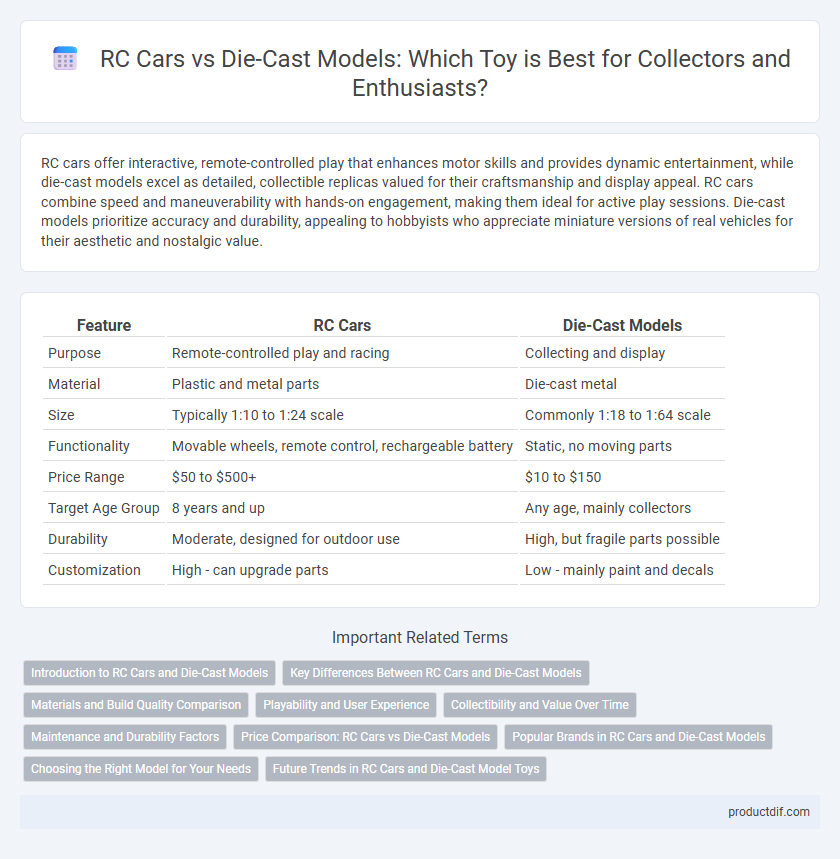RC cars offer interactive, remote-controlled play that enhances motor skills and provides dynamic entertainment, while die-cast models excel as detailed, collectible replicas valued for their craftsmanship and display appeal. RC cars combine speed and maneuverability with hands-on engagement, making them ideal for active play sessions. Die-cast models prioritize accuracy and durability, appealing to hobbyists who appreciate miniature versions of real vehicles for their aesthetic and nostalgic value.
Table of Comparison
| Feature | RC Cars | Die-Cast Models |
|---|---|---|
| Purpose | Remote-controlled play and racing | Collecting and display |
| Material | Plastic and metal parts | Die-cast metal |
| Size | Typically 1:10 to 1:24 scale | Commonly 1:18 to 1:64 scale |
| Functionality | Movable wheels, remote control, rechargeable battery | Static, no moving parts |
| Price Range | $50 to $500+ | $10 to $150 |
| Target Age Group | 8 years and up | Any age, mainly collectors |
| Durability | Moderate, designed for outdoor use | High, but fragile parts possible |
| Customization | High - can upgrade parts | Low - mainly paint and decals |
Introduction to RC Cars and Die-Cast Models
RC cars offer interactive play with remote-controlled speed and maneuverability, appealing to enthusiasts who enjoy hands-on operation and customization. Die-cast models provide highly detailed, collectible replicas with a focus on craftsmanship and authenticity, often favored by collectors for display rather than active use. Both types showcase distinct value: dynamic engagement in RC cars versus static precision in die-cast models.
Key Differences Between RC Cars and Die-Cast Models
RC cars feature remote-controlled motorized functionality allowing real-time maneuvering, while die-cast models are static, collectible replicas primarily designed for display. RC cars offer interactive play experiences with components like electric motors, batteries, and controllers, contrasting with die-cast models' emphasis on detailed craftsmanship and accurate scale representation. Furthermore, RC cars require maintenance and battery management, whereas die-cast models demand minimal upkeep, focusing on preserving paintwork and structural integrity.
Materials and Build Quality Comparison
RC cars feature durable plastic and lightweight metal components designed to withstand impact and provide flexibility during operation, enhancing performance and longevity. Die-cast models primarily use zinc alloy metal, offering a solid, heavy feel with precise detailing but less resistance to damage from drops or rough handling. The build quality of RC cars balances robustness and agility for active play, while die-cast models emphasize craftsmanship and display aesthetics.
Playability and User Experience
RC cars offer dynamic playability with remote control features, enabling users to race, perform stunts, and navigate various terrains for an interactive experience. Die-cast models prioritize detailed craftsmanship and realism, making them ideal for collectors who value display and tactile appreciation over active use. The user experience with RC cars emphasizes engagement and excitement, while die-cast models provide aesthetic enjoyment and historical authenticity.
Collectibility and Value Over Time
Die-cast models often hold higher collectible value due to their detailed craftsmanship and limited production runs, making them sought after by collectors and increasing in worth over time. RC cars, while popular for their interactive play features, generally depreciate faster because of wear and technological obsolescence. Collectors prioritize rarity and condition, with pristine die-cast models frequently achieving significant appreciation in auctions and specialty markets.
Maintenance and Durability Factors
RC cars require regular maintenance, including battery care, motor lubrication, and tire replacement to ensure optimal performance and longevity. Die-cast models offer superior durability with minimal upkeep, as their solid metal construction resists wear and damage over time. Choosing RC cars suits enthusiasts who enjoy mechanical involvement, while die-cast models appeal to collectors seeking low-maintenance, long-lasting display pieces.
Price Comparison: RC Cars vs Die-Cast Models
RC cars typically range in price from $50 to over $500 depending on features like speed, build quality, and remote control technology, while die-cast models are generally more affordable, costing between $10 and $100 based on brand and detail level. The higher cost of RC cars reflects their mechanical complexity and electronic components, whereas die-cast models emphasize collectible value and craftsmanship in metal casting. Collectors and hobbyists often balance between the interactive experience of RC cars and the static display appeal of die-cast models when considering budget constraints.
Popular Brands in RC Cars and Die-Cast Models
Popular RC car brands include Traxxas, associated with high-performance off-road models, and Axial, known for realistic rock crawlers. Die-cast model enthusiasts often prefer brands like Hot Wheels for affordable collectible cars and Matchbox for their detailed miniature trucks and emergency vehicles. Both categories offer diverse options, with RC cars emphasizing remote-control functionality and die-cast models focusing on intricate design and collectibility.
Choosing the Right Model for Your Needs
Selecting between RC cars and die-cast models depends on your preference for interactivity versus display value. RC cars offer remote-controlled functionality enhancing playtime and skill-building, while die-cast models provide detailed craftsmanship ideal for collectors and static showcases. Understanding whether you prioritize dynamic engagement or aesthetic appeal will guide your choice effectively.
Future Trends in RC Cars and Die-Cast Model Toys
Future trends in RC cars include enhanced AI integration, enabling autonomous driving and smart obstacle avoidance, while improvements in battery technology are extending playtime and performance. Die-cast model toys are evolving with augmented reality features and collectible digital certificates to increase interactivity and authenticity. Both segments are leveraging sustainable materials and advanced manufacturing techniques to meet growing consumer demand for eco-friendly and high-quality products.
RC cars vs die-cast models Infographic

 productdif.com
productdif.com